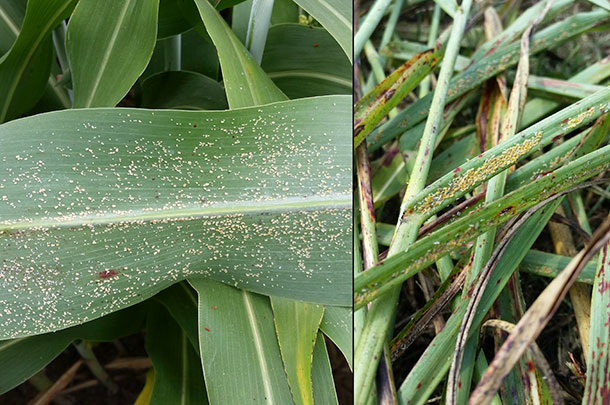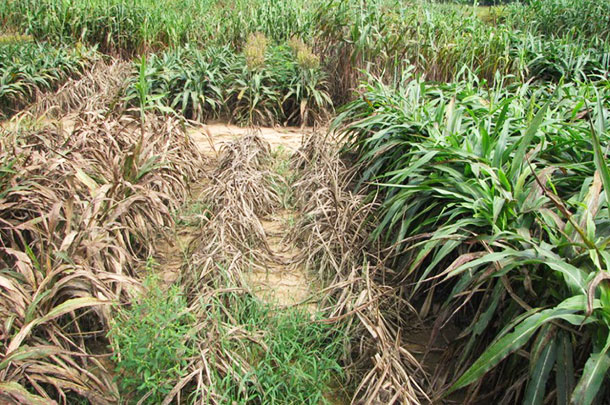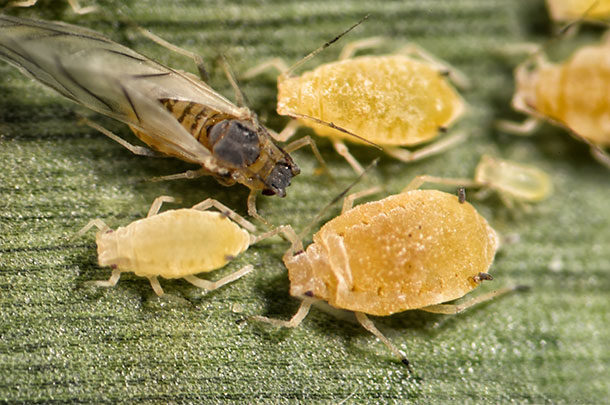The first report of a new sorghum-feeding sugarcane aphid came in the summer of 2013 from Beaumont, Texas. Whether by genetic mutation or an introduction of a new biotype from outside the U.S., the sugarcane aphid developed an affinity for all members of the sorghum family, including forage sorghum, grain sorghum, sorghum-sudangrass, sudangrass and even johnsongrass. By the end of 2013, there were reports of sugarcane aphids damaging sorghum in four states and 38 counties. By the end of 2015, sugarcane aphids were wreaking havoc in 17 states. Sorghum producers should assume that it will be a perennial problem.
Signs of sugarcane aphid damage begin with the appearance of honeydew, the shiny sugary excretion of the aphids, on the leaves. This is also usually accompanied by yellow to reddish-brown leaves. Black sooty mold will often begin to grow on the honeydew sheen. This sooty mold blocks light and reduces photosynthesis. Between the loss of carbohydrates to the sugarcane aphid and the reduction in photosynthesis, yield reductions can be extremely large (50 to 80 percent yield reduction). In addition, the honeydew and sooty mold can create such a sticky and matted mess that running a combine or silage chopper through the crop is practically impossible, resulting in 100 percent yield loss.
Sugarcane aphid populations can build extremely rapidly, doubling every one and a half days (Photo 2). Entomologists who research this insect report that all sugarcane aphids are female, reproduce asexually and live for an average of 28 days. This rapid population growth poses one of the major challenges with sugarcane aphid management. Regular scouting is critical.

It does appear that the aphids do not overwinter in colder climates. For example, overwintering populations have been found in south and central Texas, but not in northern Texas (yet). So, populations build from south to north. However, the winter of 2015-2016 was relatively mild in the southeastern U.S., and reports of sugarcane aphid populations began in Texas in May 2016.
Clearly, the sugarcane aphid is a very serious challenge to the production of any sorghum species. Forage growers across the southern half of the U.S. should account for the risks. Some may even find that summer annual forage species that are not damaged by this insect (e.g., corn, hybrid pearl millet, etc.) may be a better choice for their farm and management abilities.
Still, many will find that one of the various sorghum species is the most economical option for high yields and nutritive value. For these growers, entomologists and agronomists have come up with some management strategies to help minimize the risk of damage from the sugarcane aphid. So, the forage-type sorghum species can still be grown economically as long as attention is given to the following management guidelines:
1) Plant in the first weeks of the recommended planting window
Although the aphid may not be present in most areas at planting time, an early planting may avoid the heavier infestations that occur late in the season. Late double-crop plantings (e.g., planting forage sorghum after corn silage) are at greatest risk of severe infestation.
2) Buy time by using an insecticide seed treatment
Yield losses are greatest when sugarcane aphid damage occurs early in the growth of the crop. Treating seed with an insecticide substantially limits seedling infestations for 30 to 40 days after planting. Insecticides such as clothianidin (e.g., NipsIt Inside, Poncho), imidacloprid (e.g., Gaucho, Attendant) and thiamethoxam (e.g., Cruiser) are effective. Label requirements differ, so check the label for guidance on harvest and grazing restrictions.
3) Regularly scout sorghum fields and treat if thresholds are exceeded
Examine the underside of leaves for the aphids or the sheen of honeydew on the leaf surface. After the initial detection of aphids, scout fields twice per week to stay ahead of the rapid population increase. Treatment thresholds vary by state and growth stage, so check the recommendations in your area. As a rule of thumb, the treatment threshold for forage-type sorghums in most areas is to treat when 25 percent of the plants have leaves with 50 or more aphids on them.
4) Beneficial insects assist sugarcane aphid control
Lacewings, lady beetles, parasitic wasps and syrphid fly larvae are attracted by the presence of the sugarcane aphid and the honeydew. These insects are beneficial insect predators that can help slow the growth of aphid populations. Though they are usually overwhelmed by the rapid population growth of the sugarcane aphid, care should be taken to select insecticides that are effective and do not kill beneficial insects. Pyrethroid insecticides generally are not effective against sugarcane aphids but will kill many beneficial insects. Killing the beneficial insects can result in a flare-up of infestations. Avoid pyrethroid insecticides for controlling other pests of sorghum (e.g., sorghum midge, cutworms, headworms, armyworms, etc.).
5) Use a recommended insecticide
Rapid growth in the sugarcane aphid population can be difficult to control; however, there are some insecticide options that are effective. In most areas, flupyradifurone (e.g., Sivanto) and chlorpyrifos (e.g., Lorsban, Nufos, etc.) are labeled. Special emergency exceptions have been granted in some states for additional insecticide options that are effective, so consult with your local extension office for recommended varieties and refer to the labels for guidance on treatment schedules, posttreatment harvest intervals and grazing restrictions.

6) Ensure insecticides are applied with effective coverage
Application later in the crop’s development can be especially challenging. “High-boy” or aerial applicators may be the only choice in some situations. This requires even more attention to the application rate (gallons per acre or GPA), sprayer speed and nozzle selection to ensure the insecticide penetrates the canopy and the application hits the underside of the leaf. In general, application rates should be a minimum of 10 GPA by ground and 5 GPA by air.
7) Consider harvesting or grazing off the crop early if sugarcane aphids threaten
It may be best to harvest or graze part or all of the crop if sugarcane aphid populations have been spotted in or near the field, even if the timing means sacrificing yield. This is often a case-by-case decision, so consult with your local extension personnel, crop consultant or nutritionist to determine the best strategy.
Entomologists and agronomists across the southern U.S. are working hard to develop better management strategies. There is also some hope that sugarcane aphid tolerant or resistant varieties may become available, both in the grain and forage-type sorghum species (Photo 3). Until then, adhere to the aforementioned seven habits for highly successful sorghum production. ![]()
Dr. Dennis Hancock is an associate professor and forage extension specialist for the University of Georgia. Email Dr. Dennis Hancock.
PHOTO 1: Immature and mature, winged sugarcane aphids. Photo provided by Patrick Porter, Texas Cooperative Extension, Bugwood.org
PHOTO 2: Sugarcane aphids on the bottom side of forage sorghum (left) and johnsongrass (right). Photos provided by Nicholas Seiter, University of Arkansas Division of Agriculture, Bugwood.org (left), and Deidre Harmon, University of Georgia (right).
PHOTO 3: Some varieties of grain and forage-type sorghum are being screened for sugarcane aphid resistance in trials across the southern U.S., and some lines have exhibited tolerance. Photo provided by Dr. David Buntin, University of Georgia.








